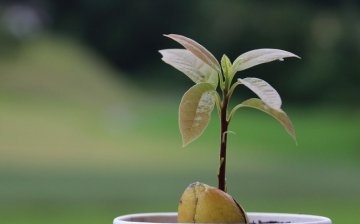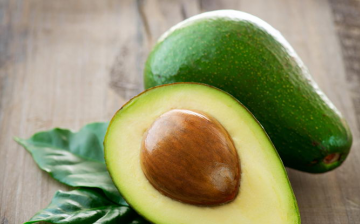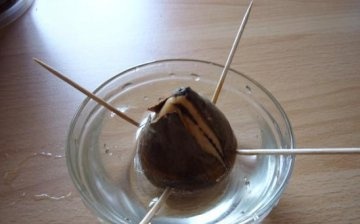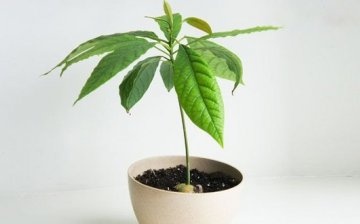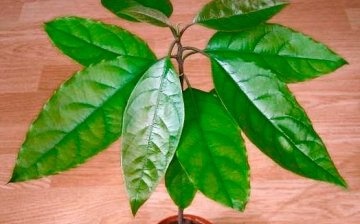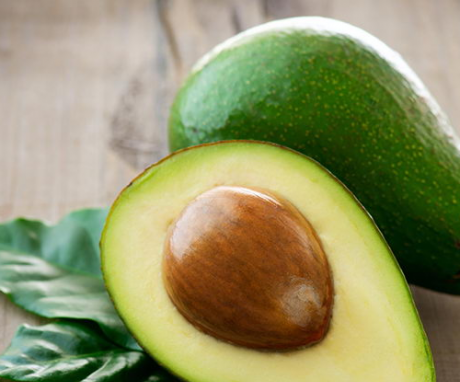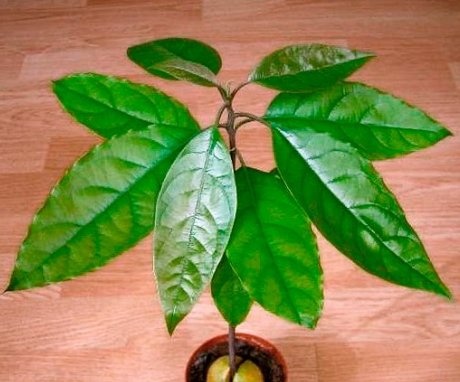How to properly grow avocados at home?
Many gardeners collect collections of citrus fruits and other exotic plants. Some specimens of the species can be bought. Saplings avocado hard to find, almost impossible. There are no them in specialized stores, and buying a sprouted specimen from your hands is unreliable. Another way to get an interesting pet is to grow it yourself at home on a windowsill.
Content:
- Preparation of the seed, container and soil
- Landing: timing and rules
- Care Tips
- Transplanting an adult seedling
Preparation of the seed, container and soil
At first glance, growing a full-fledged plant is difficult. But if you know certain points of the choice of planting material, as well as the necessary steps for rooting, then it will not be difficult to cope with the process.
The first step is to acquire a ripe avocado. Most often, unripe fruits are sold in stores. They are placed next to bananas and apples, which tend to release ethylene (a gas that accelerates ripening).
The degree of maturity is easy to determine: when the sides are squeezed, the fetus restores the dents that have appeared to their original position.
Only in a fully ripe fruit is the bone capable of germinating. To grow a full-fledged tree, take a large bone. Such an avocado kernel contains enough vigor for germination and good development of both roots and stems.
Preparatory work:
- Before planting, the bone is carefully removed from the fruit. The pulp is carefully cut in a circle until it touches the hard core. Manipulations are carried out carefully and carefully so as not to damage. If done correctly, the core will easily pull away from the edible pulp. After the kernel is washed, peeled from the outer brown peel, left to dry.
- For planting, you need to prepare a medium-sized container - no more than 10 cm in diameter. The soil is taken light, loose, rich in nutrients. The substrate should contain humus, garden soil, peat and sand. Each of the constituent parts is taken in the same proportions. Lime is added to this mixture in the amount of 2 parts of the total volume of the soil.
- The pot is prepared with large holes in the bottom. The plant does not like stagnant water, so it is necessary that the water does not stagnate in the pot. Drainage (expanded clay or polystyrene) must be placed at the bottom of the container.
Thus, properly prepared planting materials will facilitate the rapid germination of a young sprout.
Landing: timing and rules
Planting the kernel is required immediately after it dries. It is not recommended to postpone the landing for several days after the preparation of the knuckle. The germination rate is significantly reduced.
There are 2 ways to plant a bone:
- Closed - lightweight, effortless. Guided by this path, the core is placed in the ground. First of all, a container is prepared, at the bottom of which the drain is placed. After that, the soil is filled up. Inside it, it is necessary to leave a depression 2-3 cm in depth, so that the placed bone is deepened by 1/3 of the total volume. After planting, you need to water the seedling. Water must be taken at a settled, room temperature, so that it has a low salt content. The best option is filtered liquid.It is important to be careful about soil moisture. It is not recommended to moisturize or overdry the soil too much.
- Open - an original and interesting method. The stone is peeled from the upper dense peel. Neat small holes should be made in the structure of the kernel, maximum 5 mm deep. Insert toothpicks or matches into them. Holes are needed to mount the structure on the neck of a glass or can, with the pointed end facing up. Water is poured into the container just enough so that the upper cavity of the core peeps out of the water by 2/3 of the volume of its entire size. You can do without matches inside the body of the nucleus. But then the knuckle is placed at the bottom of the container, filling it with 1/3 of water.
After any of the planting methods, you need to monitor the water level and add it as needed. The temperature of the liquid should be no more than + 23- + 25 C. Activated carbon can be added to the container or wood ash... They will saturate the liquid with nutrients. When the seedling germinates, the favorable temperature should not drop to +12 C. Otherwise, all efforts will be in vain.
When the first roots appear, you should not rush to transplant into the ground. Gotta wait until root system will grow. When the roots reach 3 cm in length, you can take transplant... At this moment, a green sprout may appear from a cracked core. Now you need to carefully remove the knuckle from the water, remove the supports and place it in the ground with a blunt base inward. Be careful not to damage the fragile roots.
Care Tips
How to properly care for your indoor avocado:
- Avocado loves light, but grows well in the shade. You should not leave in the midday sun - the leaves will first acquire a red tint, and then "burn". It is advisable to place an avocado pot on the west window. In winter, they are additionally illuminated artificial lighting, since the seedling needs 15 hours of daylight for normal growth.
- The exotic bush is thermophilic, grows rapidly at a temperature of +18 C. In 3 months, under favorable conditions, it can stretch up to 50 cm in height. If the degrees in the room decrease to +12 C, then the plant will begin to throw off the leaves and go into a dormant stage. In dry air, the greens turn brown and then fall off.
- Watering need frequent but moderate. The soil should remain slightly damp 2 cm deep. Loves frequent spraying and sump watering.
- In the first months after planting a young tree, feeding is not required. Only after 8-10 months can supplements be added. During the next year, it is recommended to apply fertilizers no more than 4 times: 2 times in spring (March, May) and in autumn (September, November). Fertilizers are applied mineral or any suitable for citrus or indoor flowers.
- The plant loves to grow upward. Does not form lateral branches on its own. If you do not follow its growth, then the bush can grow up to 17 m.In the limited space of the room, such a height is not acceptable. It is important to do regular pinching of the upper kidneys. Due to this process, the tree will begin to branch and grow in breadth.
Thus, observing the small rules for caring for an avocado, you can easily grow a beautiful exotic specimen at home.
Transplanting an adult seedling
The avocado grows quickly and the first small pot will become cramped within a few months. When the bush stretches 15 cm in height, it is time to transplant. Up to 3-4 years, the plant is transplanted every year. After that, you can limit yourself to changing the flowerpot once every 3 years. Regular transplanting has a positive effect on the growth and development of young trees.
It is best to carry out the transshipment process immediately after winter.
At this time, the plant, rested after the winter dormant period, is ready for a new round of life. For transshipment, the pot is purchased slightly larger in diameter.When the bush is removed from its familiar place, it is not worth shaking off the soil from the roots. This method of transplanting contributes to quick acclimatization in a new place. An empty place is covered with fresh prepared earth.
If replanting the tree is not possible, it is recommended to remove the top layer of the earth a few centimeters deep. Spill the remaining soil abundantly with boiled, settled water. On top, instead of the harvested soil, pour fresh substrate.
Every owner of a self-grown avocado dreams of fruit. In order for fruits to appear, you need:
- grow not 1 tree, but several
- place seedlings close to each other so that cross-pollination occurs
- let the plant grow up to 2 meters in height
- pinch the top
- to do vaccination or purchase a grafted seedling
If you follow the rules, then there is a chance that a tree in the 5th year will be able to please with a few fruits. Thus, it is not difficult to grow an avocado from a seed at home, it is more difficult to wait for fruits from it. The main thing for growing is to choose the right planting material.
More information can be found in the video:



